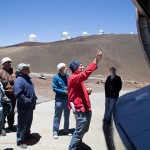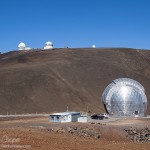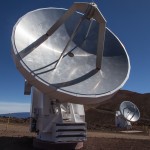In past years the club has toured the various optical observatories on Mauna Kea. Telescopes like Keck, Gemini and CFHT represent some of the largest optical telescopes in the world. There are a set of telescopes on the summit that often get overlooked, the submillimeter observatories. CSO, JCMT, and SMA all operate beyond the infrared in the submillimeter wavelengths of 0.3 to 1.4mm. These instruments enable the study of the cold and dark universe. The vast clouds of gas and dust than make up so much of the cold material between the stars and galaxies. The raw material from which everything we know is created, and to which we will return one day when the Sun has exhausted its hydrogen fuel.

Personally I had never visited these facilities, not during my seven years on the mountain. This is something that had to change. I suspected that this was true of most of the West Hawaii Astronomy club membership. It is even more imperative in that one of the facilities, CSO, is to be decommissioned and dismantled in the next few years. Thus the goal of visiting at least a couple of the submillimeter facilities to see the other side of Mauna Kea astronomy.
When arranging the tour I contacted all three submillimeter facilities on the summit. I would have considered getting two out of three a success, I knew that there was no way I would manage to get all three scheduled for a single day. The submillimeter observatories have much smaller staffs than the large optical telescopes like Keck, thus providing a tour to a visiting group is much more difficult. In the end all three observatories were able to provide a tour on the same afternoon, something I am still surprised about. A great deal of gratitude is due to the folks who drove up the mountain on a Saturday to give our group a wonderful tour.
Meeting at the MKVIS we gathered in the presentation room to do our safety briefing and to organize the remainder of the tour. Most of the folks in the group had been on the summit multiple times before, my presentation on the dangers of altitude quickly turned into a conversation with everyone relating their experiences on the summit, probably more informative that way. After a little lunch we piled into a handful of 4WD vehicles and headed up top.

First stop was the first submillimeter telescope on the mountain, CSO, the Caltech Submillimeter Observatory. This pioneering telescope was one of the first to open up the submillimeter universe to study.
The dish of a submillimeter instrument is something of a cross between radio telescopes and optical telescopes. At first glance it may appear to be a simple radio antenna like the VLBA facility found at 11,000ft on Mauna Kea. The similarity fades when you look a little closer. To form an acceptable image the surface of the submillimeter telescope antenna must be accurate to a small fraction of the wavelength being received. For a submillimeter telescope the operating wavelength is as short as a few hundred micrometers, thus these parabolic antennas must be accurate to tens of micrometers (about a thousandth of an inch) across the entire surface. Deeper in the telescope, the mirrors used to direct the collected energy into the detectors look more like those in optical telescopes, surfaces of polished aluminum.
Our next stop was JCMT, the James Clerk Maxwell Telescope. This telescope is actually the largest telescope on the mountain, at least in terms of collecting area with a 15-meter dish. JCMT also hosts the most advanced submillimeter instrument in the world, SCUBA-2, a submillimeter camera. Our guides for the day would be Graham Bell and Daniel Burke.
The submillimeter camera SCUBA-2 was a highlight of the tour. The instrument hosts one of the coldest places in the universe inside its vacuum dewar. The detectors are cooled to less than 0.1°C Kelvin, just a fraction of a degree above absolute zero. At this cold temperature an array of superconducting sensors create two 64 x 80 pixel arrays sensitive to two different frequencies, at 0.85mm and 0.45mm wavelengths. This is a 10,240 pixel camera. Tiny by optical standards where pixels are counted in their millions, enormous by submillimeter standards.

We started our tour of the SMA, Smithsonian Submillimeter Array, out in the field of antennas. This telescope is actually an interferometric array of eight six-meter dishes. These antennas sit on concrete pads spread across the better part of a square kilometer. The antennas can also be reconfigured into different sized areas depending on the observing needs for resolution and sensitivity.
Our guide, Glen Petitipas, talked about the antenna design and the receivers, allowing us to tour the electronics bay at the back of one of the telescopes. Housed at the rear of the antenna, in a closet sized room, is a set of equipment that appeared much like a miniature version of what we saw at the cassegrain focus of the JCMT… A set of polished aluminum mirrors directed the energy to a set of receivers. A white box crammed with high tech equipment.
Glen sent a few commands from the computer in the antenna and made the entire array move together for us. As we stood among the antennas they turned about, slewing smoothly to a new position. It is amazing how small these antennas look from any distance, and how big they really are.

The last part of the tour was another part I was looking forward to… The SMA correlator. This is the giant processor that combines the signal for each dish to crate an image of the science target. Interferometry requires an enormous amount of processing power, an array of processor capable of trillions of calculations each second. A room filled with rack after rack of identical cards, each hosting dozens of custom chips do the job.
More amazingly the folks at SMA are currently commissioning a new correlator. Built with the technology available today, as compared to two decades ago, a single rack of modern FPGA’s is capable of doing the job a roomful of older processors performed. Not only doing the job, but actually surpassing the performance of the older machines. One small rack sits behind the twenty odd racks, a new correlator capable of several times the performance.
Submillimeter astronomy is the study of the cold matter, the dark-side of the universe if you will. But these instruments were hardly dark during this tour, indeed we learned a great deal. A wonderful tour allowing a glimpse into this different specialty in astronomy. Since many of the club members who participated also volunteer at the VIS and other public outreach events, I hope that they can pass along a little knowledge and appreciation for the submillimeter observatories of Mauna Kea.


That be one hoTTTT write up Dude. Its was lots of fun, with a sprinkling of pain for good measure.
That said lets do it again some time.
Aloha
PS have fun in your vacation and bring back some good shots when you go